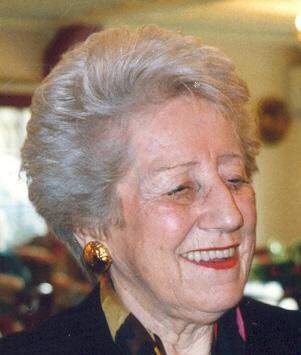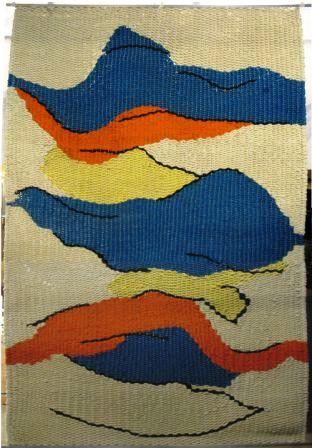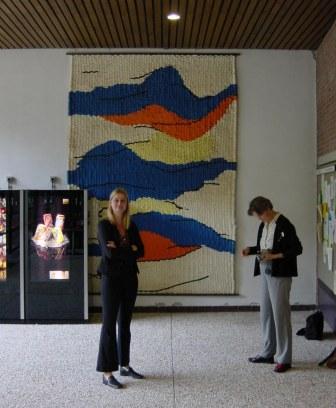Wil (W.E.M.) Fruytier-van der Lande (1915–2007), one of the pioneers of modern art wall tapestries in the Netherlands, made most of her work in the period between 1950 and 1980. Internationally, Wil Fruytier is known from 1961 onwards and her works were shown in Venice at the Biennale. She became known for her tapestries of ropes, for which she used both natural materials as well as polypropylene. Two works of art by Fruytier, Fête I (1969) and Fête II (1969) were submitted to Instituut Collectie Nederland (ICN)* to research the possibilities for conservation/restoration. Both works of art are the same size (355 × 250 cm) and were woven with black, white, yellow, orange and blue polypropylene (PP) ropes.
Until the 1980s, textile works of art had a handcrafted image. ‘Textile art is sculpture art’ is a citation from the end of the 1970s. Artists who chose textile as one of the materials as a means of expression were fighting for a place in the established art world. They regarded their works as expressions of conceptual art, for which not only the appearance and the technique, but moreover, the concept of the artwork is central.
Internationally, Wil Fruytier is known from 1961 onwards and her works were shown in Venice at the Biennale. She became known for her tapestries of ropes, for which she used both natural materials as well as polypropylene. Due to the large sizes involved, her work is often exposed in large spaces such as entrances of universities, hospitals and commercial banks; however, her works are also exhibited in museums (Megens 1991; Boot 2001).
Inventory of artworks
In 1996 a list of art works was made by Wil Fruytier in preparation for an exhibition of her work in the Dutch Textile Museum in Tilburg. The exhibition titled, Wil Fruytier Architect in Textiles and was created by Caroline Boot. This list was used by conservator Loutje den Tex in 1999 to carry out research into the wherabouts and condition of other works of Wil Fruytier in which polypropelene is used. Of the 35 works with this material only nine were actually found! A lot of the works had been de-accessioned and destroyed, most likley because of their poor condition. Others were untraceable because of company mergers or moving offices. The list can be accessed on the right in Dutch and in English.
Fête I (1969) and Fête II (1969)
Two works of art by Wil Fruytier, Fête I (1969) and Fête II (1969) were submitted to Instituut Collectie Nederland (ICN)* to research the possibilities for conservation/restoration. The artwork Fête I belongs to the art collection of the ING bank in the Netherlands. This wall tapestry has always been exposed in the hall of a bank and was ‘donated to science’, i.e. to the conservation research department of the ICN in 2005 in order to investigate the possibility of conserving the artwork. The other artwork, Fête II, was acquired by the University of Nijmegen in the Netherlands in 1971. This tapestry is still exhibited and, for more than 36 years, has been exposed in the hall of the university.
Both works of art are the same size (355 × 250 cm) and were woven with black, white, yellow, orange and blue polypropylene (PP) ropes. The ropes are made of slit film fibres and have all become brittle due to degradation (van Oosten et al. 2006). The white fibres, containing titanium dioxide (TiO2), are the most seriously degraded; the yellow, orange and blue fibres are moderately degraded. The black fibres are in a rather good condition due to the fact that black pigments have an inhibitive effect on photo-oxidation (Davis and Sims 1986). Pigments are most effective ultraviolet (UV) absorbers and a concentration of 5% of various organic and inorganic pigments has been found to restrict degradation of PP to surface oxidation, thus increasing the time to failure (Davis and Sims 1986). However, the white ropes used for the warp are in a good condition, being protected from light and UV radiation by the coloured weft ropes. In total, the whole reverse sides of both tapestries are in a good condition because these sides were never subjected to light and UV radiation. A condition report was made of Fête I in August 2007 by Thea van Oosten (conservation scientist) and Katharina Haider (conservation intern ICN).
References
- Boot, C. (2001) Dutch Textile Museum, Exhibition ‘Tegendraads’ August 2001. Beeldende kunst 1965–2000
- Davis, A. and Sims, D. (1986) Weathering of Polymers. London: Elsevier.
- Megens, F. (1991) Doctoraalscriptie, Universiteit Nijmegen.
- van Oosten, T.B., Joosten, I. and Megens, L. (2006) ‘Man-made fibres from polypropylene to works of art’, in The Future of the 20th Century: Collecting. Interpreting and Conserving Modern Materials, C. Rogerson and P. Garside (eds). London: Archetype Publications, 61–6.
* Instituut Collectie Nederland became part of the Cultural Heritage Agency of the Netherlands (RCE) in 2011.



